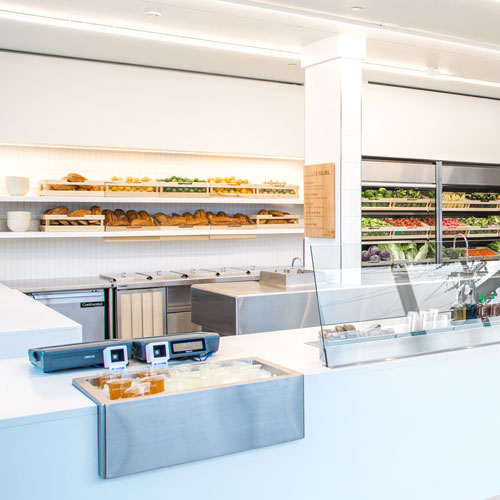THE KRYSTAL COMPANY WANTS FAMILIES and customers of all ages to come to its restaurants, sit down, and enjoy a meal together. Yet a significant portion of Krystal’s business comes from drive-thru customers. That’s why the Atlanta-based quick serve restaurant chain, famous for its unique hamburger, is looking to revitalize its 83-year-old brand by remodeling and revamping 360 locations within five years.
“You can go anywhere to get a hamburger, but you can only get a Krystal [in] one place,” says Brian Blosser, Krystal’s vice president of development and construction. “Our product is unique and we need an environment and a building as unique as our product. We need to be inviting, we need to encourage people to stop by.”
Blosser, who has worked in the food industry for nearly 30 years, including three years with Krystal, says many of the Krystal locations are three decades old and in need of a face-lift.
“We’re really making quite a revolutionary change to the brand,” he says. “We have more custom seating, we have created a more inviting environment, and we are placing awnings on the outside of the building to give it that iconic diner feel.”

The company’s goal is to differentiate Krystal as a brand and offer more of a casual setting in a quick-service restaurant.
The remodels cost anywhere from $130,000 to $177,000, depending on the building size. Improvements include new awnings, exterior paint, upgraded parking lots, lighting, tile, and replacing wallpaper with paint. Most feature a color scheme of walnut and red with upscale lighting and pictures on the wall, Blosser says.
Krystal remodeled 31 restaurants in 2015 and identified 35 locations for upgrades in 2016. It works with vendors to mass-produce elements such as awnings, siding, and wainscoting. The finishes are shipped to each site and kept in a storage container so everything is readily available for contractors. That way, the restaurant only has to close for a maximum of five days. The company typically starts work on a Monday and reopens by Friday afternoon.
During that time, employees go through an off-site boot camp where they’re recertified in cooking, hospitality, and the new point-of-sale system. They also receive new uniforms to match the updated décor.
“You can’t just go in and remodel a building and expect to see a change in it,” Blosser says. “You have to change the total atmosphere, and that includes your people as well.”

Certain restaurants in parts of Florida, Georgia, and Louisiana are being remodeled with a sunrise design featuring vibrant orange and yellow colors. The Krystal in downtown Dalton, Georgia, served as the test market for the sunrise design. Krystal wanted to match some of the exterior elements with the nearby amphitheater, Blosser says.
“If we are in southern areas or areas where there’s a predominant number of travelers who are driving through either for holiday or otherwise, we want to make sure that we use those elements as an inviting, open, airy, bright look,” Blosser says.
While the darker walnut and red color scheme resonates well in northern Georgia and Tennessee, the brighter sunrise colors do well in southern Georgia, Florida, and Louisiana, he says. Krystal offers a third design option for restaurants located in or near college towns. Those locations, including one near Georgia Tech, incorporate school logos and colors in the dining rooms.
Blosser says Krystal is particularly interested in attracting more millennials to dine in its restaurants and view it as a relevant brand since young people are the future of Krystal’s customer base.
“How do you create that craveability?” he asks. “How do you get them to try it once? Because if you do, they’ll be customers for life.”
MORE THAN GOOD LOOKS
Krystal’s remodeling projects are about more than just aesthetics—they also are designed to increase efficiency and reduce operating expenses.
Many of Krystal’s locations were built without drive-thrus and accommodated the service later. Nevertheless, the equipment layout didn’t really change when drive-thru windows were added.
Blosser says he was inspired by Toyota Motor Corporation’s set of lean management principles called the “Toyota Way.” He hired WD Partners to do a time-motion study to compare how many steps employees must take to produce food in several different kitchen layouts.
They determined that the most efficient layout is a new “V” design where the fryers, grill and Thermodyne unit are set up in a triangle.
“What they determined pretty quickly is that the “V” design was set up in such a way that people didn’t have to move very much and everything was pushed toward the front of the building, which is your front counter and your drive-thru,” Blosser says.
Blosser is also looking at new holding units, grills, and fryers that are more energy efficient and use less oil in order to speed up service and save money.


